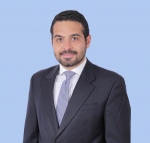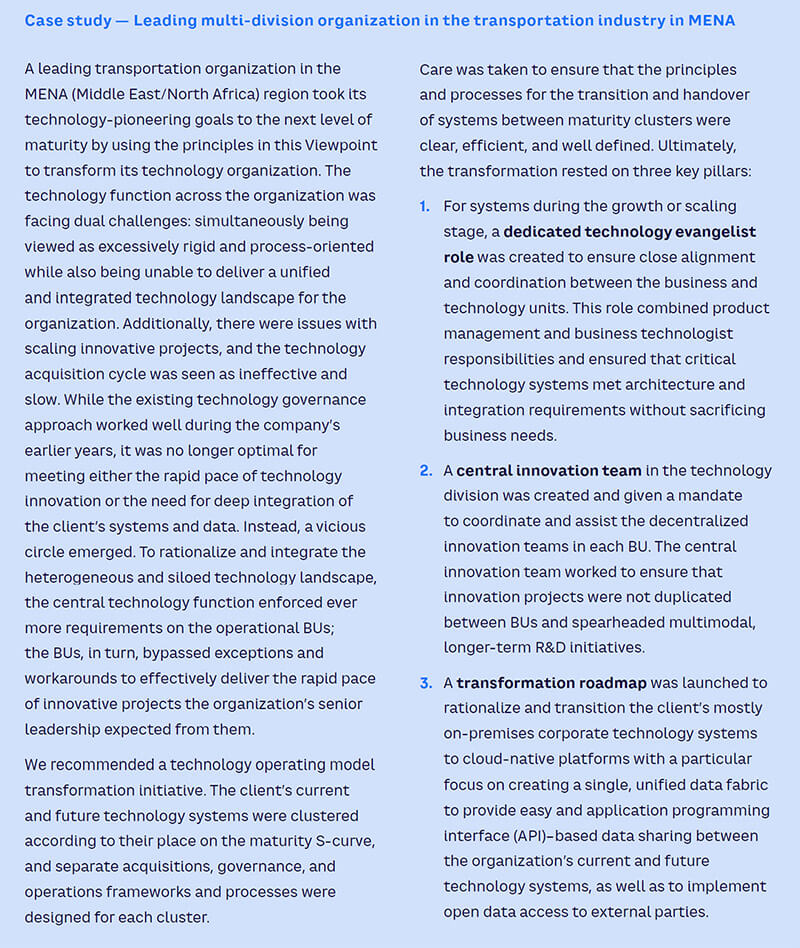
The mobility sector is undergoing rapid technological changes; organizations must adapt their technology operating models to keep pace. In this Viewpoint, we propose a differentiated, multilayer operating model for planning, operating, and governing technology systems, based on their position on the technology maturity S-curve. Adopting this approach will help companies find the right balance between agility and efficiency for each technology system in their portfolio.
NEW OPPORTUNITIES & CHALLENGES
A confluence of technological breakthroughs has disrupted the transport and mobility value chain. Travelers are accessing mobility services in new ways, new classes of vehicles are emerging, and transport networks and traffic flows are increasingly monitored and optimized in real time. This sector has often found itself at the forefront of progress, but most of its advances have always been more relevant to moving atoms than to moving bits. The latest challenge facing mobility players is the current technology revolution’s emphasis on capturing, integrating, and leveraging large flows of data.
This challenge is pressing for public transport operators for two key reasons. First, as government bodies overseeing critical public infrastructure, the guiding mantra must remain “move slowly and make sure that nothing breaks,” which is diametrically opposite to the stance often adopted by digital-native innovators: “move fast and break things.” Second, because such entities usually oversee all key aspects of transportation within a certain geographical area, it is necessary to align and integrate previously differentiated and siloed units, each responsible for its own mode of transport.
For example, the sensors embedded in advanced operational technology (OT) systems are gathering expanding amounts of data on transport infrastructure, vehicles, and passengers. Integrating this data from different OT systems will unlock new insights and synergies, for both optimizing existing operations and for planning new development.
In addition, several key disruptive technologies presently transforming other industries are driving the need for IT/OT integration within the mobility sector (see Figure 1). These include big data analytics, blockchain and distributed ledger technology (DLT), artificial intelligence (AI)/machine learning (ML), and digital twins/metaverse. For example, the widespread use of sensors and Internet of Things devices generates an abundance of data that can be leveraged to optimize transport operations, reduce costs, and improve safety. Moreover, DLT can enhance payment authentication, which helps refine the transparency, security, and efficiency of transport operations.
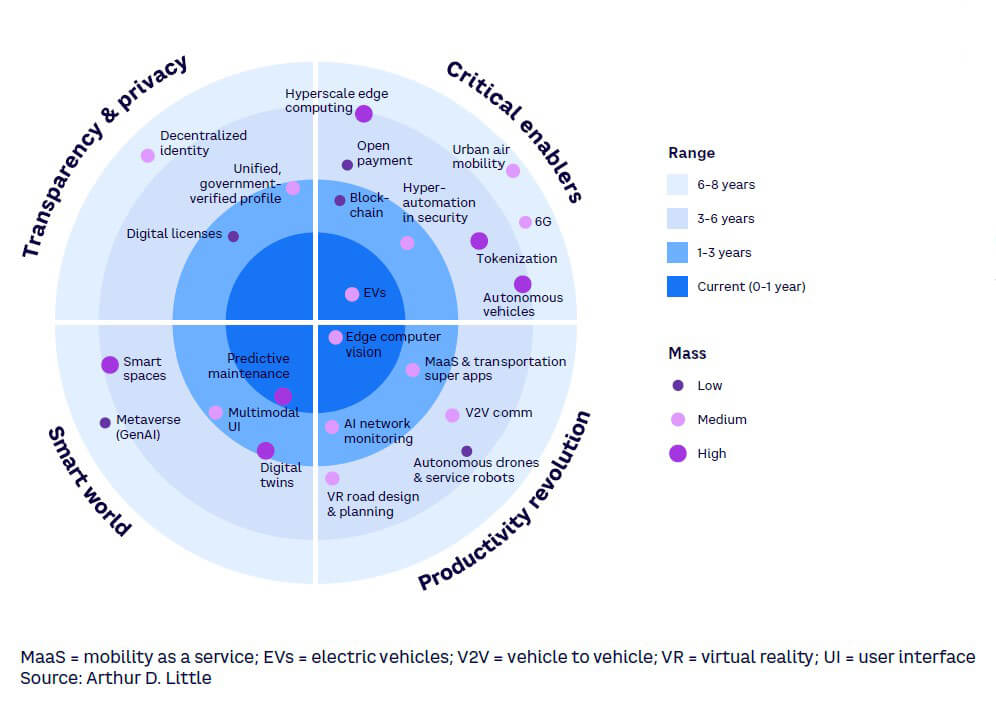
Finally, mobility involves asset-intensive operations, and digital twins — especially those powered by AI and ML — play a crucial role in facilitating sustainable asset management from the outset. Digital twin technologies offer advanced abilities for planning and designing networks while integrating essential modeling tools to simulate the behavior of urban transportation infrastructure. This enables informed decision-making and optimizes operations. In addition, digital twins can contribute to a more effective asset management approach by utilizing real-time data feeds to monitor asset conditions. This allows for identification of potential issues and implementation of predictive maintenance schedules, which ultimately optimizes operations. Consequently, downtime is minimized, and reliability is enhanced, leading to improved performance and cost savings for transportation systems.
OPERATING MODEL ARCHETYPES
Most leading transport operators have adopted an operating model structured by mode of transport, which reflects the traditional way of managing transportation. As such, most OT systems have been developed to manage transport operations for specific modes of transport and are operated by dedicated specialists, independently from OT systems for other transport modes. There has long been a tendency to consider IT separately from OT, with IT mostly seen as a support function implementing standardized, corporate-wide services.
With software continuing to eat the world, there is now a rapid convergence of IT and OT, driven by SDx (software-defined everything) and XaaS (everything as a service) — see Figure 2. This ongoing merger, both between IT and OT, and OT systems for multiple modes of transport, presents a major challenge to transport operators in terms of both organization and culture. Successfully navigating this challenge will be critical to unlocking additional innovation opportunities for transport operators. For example, the ability to analyze integrated data flows is central to smart city technologies, such as dynamic traffic operations, smart parking, and the deployment of autonomous and multimodal public transport services.
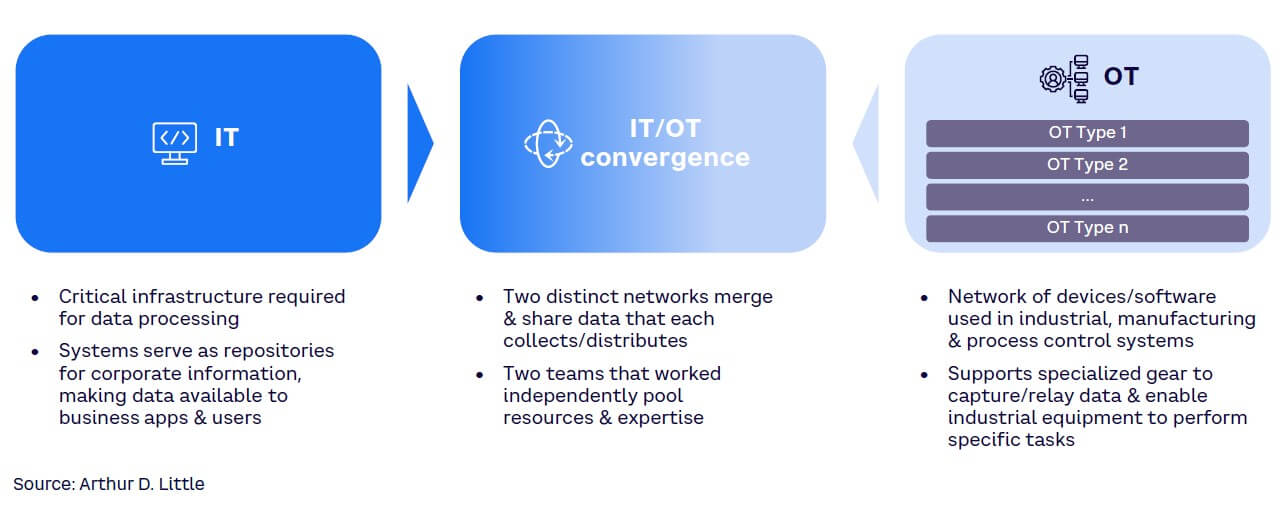
Seeing both the need and opportunity to integrate their technology operations, many public transport operators have begun to centralize all technology operations under a single organizational unit. When successfully implemented, this modification has the additional advantage of improving efficiency, an important goal for all companies, but particularly for publicly funded entities. For example, Transport for London, the local government body responsible for most of the transport network in the UK city, realized significant OPEX efficiencies (estimated at an approximate annual reduction of 50%) thanks to the full centralization of both IT and OT operations into a single organizational unit.
It is important to note that no single technology operating model archetype should be viewed as the best practice target state for technology organizations (see Figure 3). Instead, each archetype has a distinct set of advantages and disadvantages for different technologies in an organization’s portfolio and any trade-off may shift for any given technology as it matures and develops. For example, significant benefits can be gained through full IT and OT centralization, but two important drawbacks must be considered. First, successful centralization can be a daunting task; leaders of operational units may be wary of giving up control over their critical OT systems and could, therefore, often show resistance to the proposed changes. Second, a higher level of centralization typically decreases an organization’s flexibility, overall agility, and ability to innovate. Centralized organizations are a good fit for managing mature technologies toward the end of their lifecycle but are too regimented to succeed in identifying, incubating, and scaling innovative technologies.
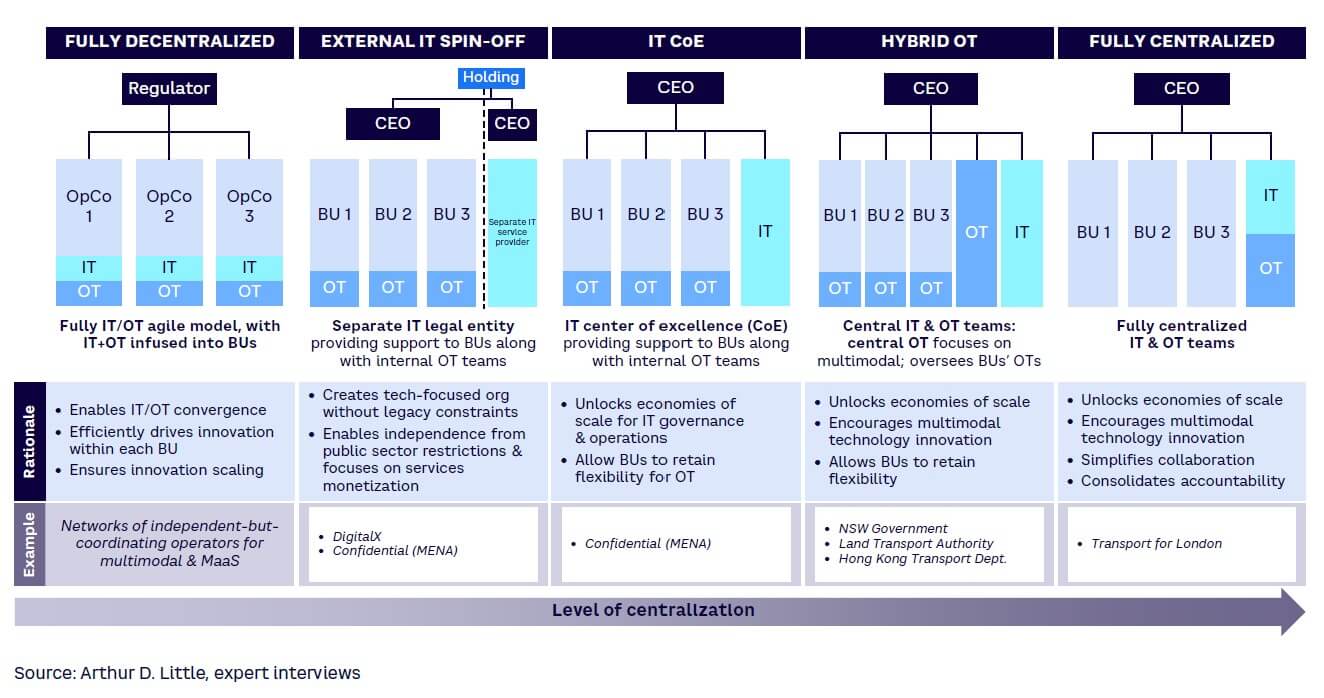
With significant technological disruption expected to continue affecting the transport and mobility sector over the medium term, responding to the convergence of IT and OT by centralizing the technology function would deliver efficiency at the expense of agility and could lead to less-than-optimal results for transport operators.
ALIGNING OPERATING MODELS TO PORTFOLIO MATURITY
Large technology functions commonly oversee sizeable portfolios of products and systems, comprised of technologies of varying degrees of maturity. Moreover, given the broader trend in technological development, the maturity of any single technology will evolve from promising but uncertain innovation to effective competitive advantage and eventually to a commonly available solution and ultimate obsolescence. This evolution has been well studied and is commonly known as the “technology maturity S-curve” (see Figure 4).
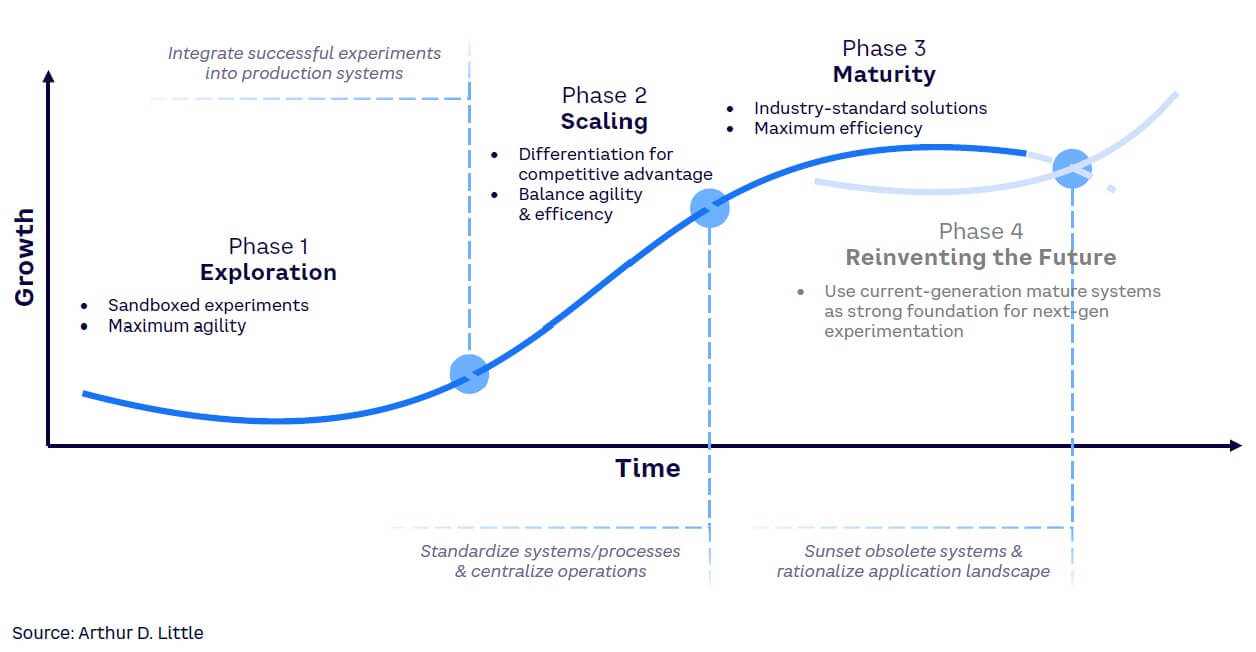
Thus, technologies at different stages of maturity have different requirements for being most effectively leveraged. In other words, different technology operating model archetypes can be a better fit for technology portfolios with a preponderance of technologies at a certain development phase. The following details highlight the three phases of the technology maturity S-curve:
-
Phase 1: Exploration — experimenting with new and innovative technologies. This stage requires high flexibility and agility and maximum proximity to the business and customer. Success during this phase is most often achieved by making multiple small bets with a high rate of failure. Governance is ad hoc, processes are difficult to define formally, and efficiency is not a key factor for success. Technologies at this stage help identify potential new areas of competitive advantage and are predominantly delivered at the proof-of-concept (PoC) or minimum viable product (MVP) level. Success is measured against OKRs (objectives and key results) set individually for each project, typically looking at user adoption or revenue-generation metrics. Financing models are more flexible and may include funding drawn from a preapproved innovation fund or pool or from external innovation partners.
-
Phase 2: Scaling — technologies that have achieved product-market fit are ready for rapid growth, or scaling. This stage requires finding the right balance between agility and efficiency. The need to develop significant new features remains, but the technology’s overall direction is becoming clear, and considerable investment is required to deliver broad market adoption. Governance and cost-control increase in importance, and stringent, frequently tracked KPIs must be imposed to verify growth of user adoption and ensure the new system fully and effectively integrates with the existing technology landscape. Technologies at this stage help strengthen current competitive advantage. Responsibilities for them must be shared between the business/product team and the centralized technology function; the interface between these two becomes critical. According to our experience, effective coordination between business and technology is ensured, through the introduction of dedicated business technology evangelist teams. These teams should have a fairly deep understanding of both the business and the technological aspects of the product or system in question and use their understanding to guide its development.
-
Phase 3: Maturity — once firmly established, technologies serve as the foundation and backbone for the functioning of the entire organization, including business-critical operations. The focus at this stage is stability and efficiency, often best achieved via the adoption of best practices and industry standards. Processes are clear, easily defined, and optimized — and must be stringently followed (see Figure 5). OPEX may be significant, but the risk of unplanned obsolescence or product failure is low. Strict, quantitative KPIs are aimed at ensuring efficiency and continuous systematic improvement. Technologies at this stage are best overseen exclusively by the centralized technology function to ensure strong integration and avoid unnecessary customization, complexity, or duplication of features. In turn, business units (BUs) must adapt their processes to the technological solution rather than having the technology tailored to their needs.
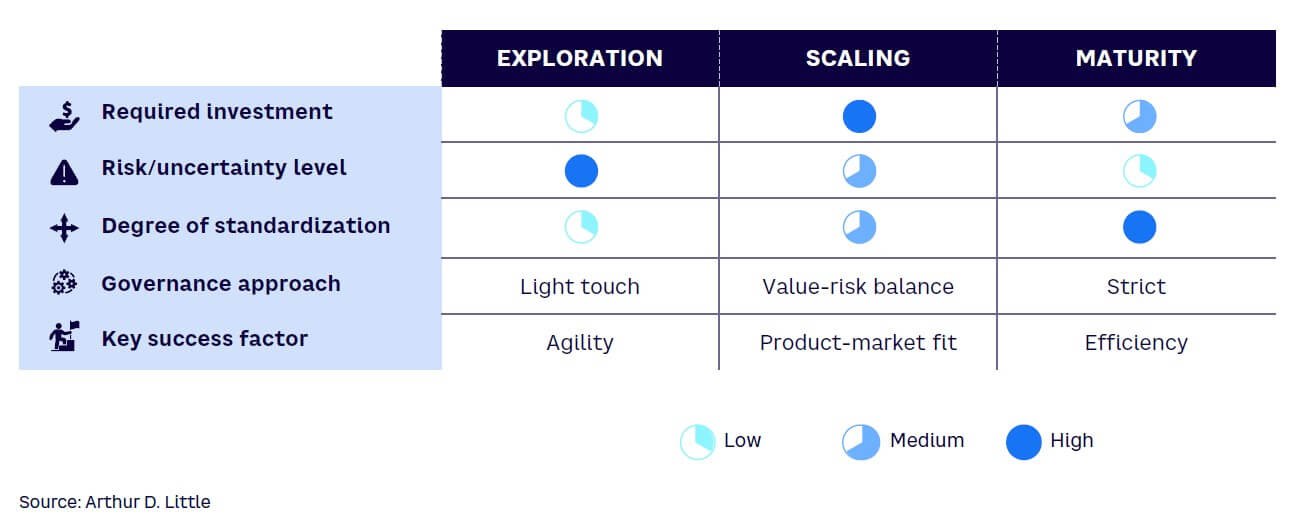
As stated earlier, no single approach or technology operating model is an ideal fit for all three of the identified technology maturity stages, as each model presents different drawbacks for each stage. The operating model archetypes and their limitations are as follows:
-
Fully decentralized (IT and OT in BUs). No process exists for centralized innovation tracking or sharing lessons during exploration. Scaling can easily be achieved within one BU, but coordination across multiple BUs is harder during the scaling stage.
-
External spinoff. Similar to the above, there is no process for OT or IT to track centralized innovations or share innovation lessons learned. The “BU versus centralized” and “internal versus external” splits create coordination hurdles, making joint scaling difficult. At the maturity stage, IT and OT live apart from each other; it is very complex to manage data integration and operational interfaces.
-
IT center of excellence (CoE). Innovation in OT is dynamic as it is centered around BUs, but IT works centrally at a very different speed. This makes it difficult to prototype technologies requiring both IT and OT components. It is also likely to be challenging to scale IT and OT scale at the same pace, especially when integrations are required. Thanks to quick and agile delivery cycles, OT is managed closely to the BUs, but the lack of centralization makes efficiency and standardization difficult.
-
Hybrid OT. During exploration, OT at the BU level can be experimented with, but IT works centrally at a very different speed, making it difficult to create prototypes with IT and OT components.
-
Fully centralized. At the exploration stage, individual BUs would not be able to identify and drive long-term and company-wide innovations, but a centralized unit would. When scaling for only one BU, it is likely to result in unnecessary overhead. The process may be too removed from the business to capture and quickly respond to product/solution fit challenges during this phase.
The archetypes are easily observable when comparing the operating models of technology companies that focus primarily on delivering technologies at a particular stage. For example, innovative start-ups will be more decentralized and focused on agility, whereas well-established players with mature services and technologies will be more centralized and focused on efficiency and integration. Furthermore, as the technologies themselves mature, this frequently poses significant transformation challenges for the organization. Initially, successful start-ups may fail at the scaling stage due to an inability to formalize their process and discipline their organization, while the most successful players of the previous technological cycle may become too centralized and move too slowly to identify and capitalize on the next generation of innovations in their field.
A MULTISPEED APPROACH
We propose extending the concept of a technology S-curve to the design of technology operating models. This aims to lessen the intrinsic tension between efficiency and agility that often creates an issue for organizations with large and complex technology functions. The proposed solution involves clustering technologies within an organization’s portfolio by their maturity level and introducing separate approaches for the planning, operations, and governance of each cluster.
Using the technology maturity S-curve as its foundation, the proposed operating model would, in effect, create three distinct and specialized operating and governance regimes within an organization. Each regime will supervise a subset of the organization’s technology portfolio, and all technologies in the portfolio will move between regimes as they mature, as if on a conveyor belt. First, all promising technologies make their way into the technology funnel and are trialed and incubated under the organization’s decentralized innovation regime. Second, any innovations that demonstrate initial success and reach their OKRs will graduate into the organization’s integration, scaling, and development regime. Finally, when technologies reach their peak scale and cease to demonstrate rapid growth, they transfer to the centralized operational efficiency and standardization regime for eventual outsourcing or retirement.
As we argue below, such a hybrid, maturity-centric technology operating model will help organizations benefit from a type of dynamic stability, which will be capable of simultaneously delivering decentralized agility with standardized efficiency of technology operations. In effect, the proposed approach provides certain operational and governance aspects of the optimal technology operating archetypes, identified above, for each of the three technology maturity stages:
-
Exploration stage. BUs are granted complete autonomy in IT and OT decisions, which is supported by dedicated teams tasked with identifying emerging technologies and conducting early-stage experiments, preferably using Agile or DevOps methodologies.
-
Scaling stage. A hybrid model facilitates the smooth expansion of projects across multiple BUs through a blend of decentralized and centralized IT/OT responsibilities. This model relies on synergistic cooperation between BU-specific teams and a centralized technology and innovation team. Adopting Agile principles is crucial for this collaboration to ensure that the specialized BU teams, which will oversee product delivery, work effectively with the central technology team, which will integrate these products into the organization’s broader technology portfolio.
-
Maturity stage. Decision-making is centralized, focusing on continuous improvement, service and tool standardization, and maximizing operational efficiency. The responsibility for operating and enhancing mature technologies and products lies solely with the centralized technology operations team, which employs traditional waterfall methodologies for implementation.
The main challenge for the proposed approach revolves around the efficient handover of technology systems from one maturity stage to the next. This challenge has two components: (1) identifying the current maturity stage for a given technology and (2) facilitating the transition of the technology or product between different teams (considering any expertise or capabilities uniquely specific to the team). Thus, for the dynamic model to be successful, organizations must pay attention to the transition of systems between each of the three stages and consequently between each relevant governance and operations regime.
The success of the transition process depends on two factors: (1) establishing clear rules or gates to govern the transition between each governance regime and (2) creating an independent and cross-functional team. This team should consist of representatives from both the BUs and the key centralized functions (e.g., technology, strategy, finance) charged with evaluating and enforcing the transition points. Below, we suggest rules for transitioning between each governance and operations regime:
-
Innovative technologies are handed over for scaling. Conditions for transition typically include proof of a good product-market fit, as indicated by fulfilled OKRs, and the need to start integrating the PoC or MVP with the broader technology landscape. In addition, a time limit is recommended for products in the experimentation stage; a product or technology that fails to reach its OKRs within a specified time frame (typically one to two years) should be considered unsuccessful and wound down to free up resources for alternative innovation opportunities.
-
Growing technologies reach maturity. Conditions for transition typically include technological growth slowing to the same rate as that of the overall organization, the broad adoption of similar technologies by industry peers, and the emergence of industry standards and best practices. This transition can present challenges, as it requires business owners to relinquish responsibilities for important systems and frequently entails refactoring or rationalizing existing applications in favor of best-practice solutions.
-
Mature technologies are retired. Conditions for transition typically include a decline in use and the emergence of more powerful alternatives at the start of their scaling phase. This transition can be considered “reinventing the future” and the fourth phase of the technology lifecycle. Timely retirement of obsolete technologies is an important process that reduces technology debt, decreases security risk, and ensures that the health of the overall technology landscape is not undermined by the need to continue supporting systems of minimal value.
Conclusion
SUCCESSFUL TECHNOLOGY & INNOVATION MANAGEMENT
We propose managing technology and innovation through a dynamic approach that leverages separate operational and governance regimes for technology systems at different maturity levels. The proposed approach requires a high level of organizational maturity to be executed effectively and aims to:
-
Deliver the right balance between agility and efficiency.
-
Align business and technology interests.
While we have developed and tested this novel approach with organizations in the transport and mobility sector, other industries with complex technology portfolios can potentially benefit from the same model, including energy/utilities (e.g., implementing smart grids), industry/mining (e.g., enabling Industry 4.0), and healthcare (e.g., utilizing smart health technologies and 4P [predictive, personalized, preventive, and participatory] medicine).




